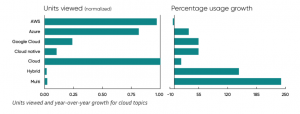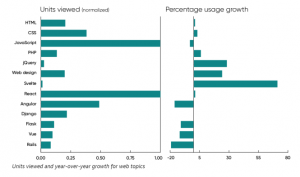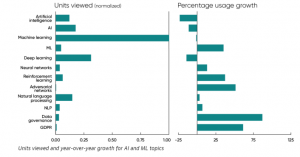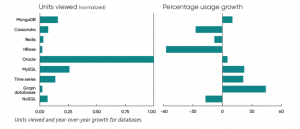Technology Trends for 2022 (Part 2)
- 2022-02-15 17:20:08
- ZenTao 3
- Original 1295
Technology Trends for 2022
2021 is a year of continuous technological development, with new technologies emerging one after another. From the mobile era to cloud computing big data, and then to artificial intelligence, machine learning, cloud native and etc. All of these technologies are gradually known to people. Technology changed day by day but the fundamental things apply. Many core technologies still play the leading roles. The arrival of new technologies not only injects fresh blood, but also promotes the continuous updating of core technologies.
On January 25, 2022, O'Reilly released the report of Technology Trends for 2022, which provides a comprehensive analysis of technology development. It counts data from January 2021 to September 2021 and compares data with the same period in 2020. It covers hot topics such as microservices, cloud services, web frameworks, Kubernetes, artificial intelligence, machine learning, databases, virtual reality, augmented reality, and the metaverse.
The report is based on four types of data, including search queries, questions asked to O’ Reilly Answers, resource usage by title, and resource usage by topic. The content that has not been collected on the platform (such as QUIC protocol or HTTP/3) is not included in the report.
As cloud services continue to evolve, what will cloud native bring us?
With the continuous development of cloud technology in the past year, the competition of cloud services has become increasingly fierce. The survey showed that AWS content decreased by 3%, while Microsoft Azure and Google Cloud content increased by 54% each, of which content about Azure was almost equal to AWS, and Google Cloud ranked third. In addition to cloud services, content about the cloud grew by 15% last year, while cloud-native content grew by a whopping 54%.
Another trend is that the content base for hybrid and multi-cloud remains very small (about a tenth of Google Cloud), but growing very fast (145% and 240%, respectively). This reflects an issue that enterprises cannot build cloud strategies with just a single cloud server. Building a cloud strategy requires realizing that cloud is inherently multi (or hybrid). The most important thing is not choosing a cloud server but how to build an effective cloud architecture across multiple cloud servers. This has become an important part of cloud native.
Source: O'Reilly
Web frameworks develop steadily, will meta frameworks break the pattern?
Web programming technology has been growing steadily over the past two years, but the content on the core components HTML, CSS, and JavaScript barely changed (up 1%, 2%, and down 3%, respectively). If Java and Python are core to enterprise and data developers, then HTML, CSS and JavaScript are even more so for front-end developers. According to statistics, content about PHP increased by 6%, content about jQuery increased by 28% and content about web design increased by 23%.
Among emerging frameworks and meta-frameworks, Svelte seems to be growing rapidly (up 71%), with Vue and Next.js seeing a decrease in content (both down 13%). If this continues, Svelte could become one of the popular frameworks within a few years.
Whereas the amount of content about the React framework was essentially unchanged (up 2%), there was a significant decrease in content about the Angular framework (down 16%). The amount of JavaScript is almost the same as that of React. Rails content decreased by 19%.
Source: O'Reilly
Schrödinger's artificial intelligence, machine learning and data
Although there are many predictions about AI appearing on the Internet, some believe that AI will face a downturn, while others say it will be the newcomer of the future. According to O'Reilly, content with "artificial intelligence" in the title decreased by 23% in 2021, while content about artificial intelligence decreased by 11% in 2021. The topic that dominates this field is machine learning (ML), with artificial intelligence accounting for only a quarter of the content of machine learning.
Now let's take a look at some of the specific technologies. The content of deep learning decreased by 14%, but the content of neural networks increased by 13%, reinforcement learning increased by 37%, and adversarial networks increased by 51%. From this point of view, the focus of developers has shifted from general content to specific content.
Also noteworthy is the significant increase in content related to data governance (up 87%) and GDPR (up 61%). Data governance and its related components (e.g., data sources, data integrity, auditing, interpretability, etc.) will become increasingly important. Regulation of data is bound to get tougher in the future. Data governance will continue to exist.
Source: O'Reilly
What is the way out for NoSQL databases?
No data and database, no machine learning. The data shows that Oracle dominates the database with a 5% increase in content, a 22% increase in open source MySQL database content, and a 17% decrease in NoSQL content, which includes Cassandra, HBase, Redis, MongoDB and etc. NoSQL is not so much a technology as it is a philosophy - dedicated to extending the number of storage options for system designers.
In NoSQL databases, MongoDB has a 10% increase in content. Cassandra, Redis, and HBase saw significant reductions in content (27%, 8%, and 57%, respectively). Although the total content of these four databases has decreased by 4% since 2020, it is 40% more than MySQL. Although the trend has shifted from NoSQL to relational databases, this is not the end result.
In the last year, usage of content with the term “graph databases” is up 44%. It’s still a small category, but that’s a significant signal. Likewise, content about time series databases increased by 21%. Time series database refers to software used to store and index time series data in time (points or intervals) and is important for applications related to monitoring, logging, and observability.
Although graph databases and relational databases are growing rapidly, relational databases still and will continue to dominate the database world, and NoSQL has no chance to replace relational databases.
Source: O'Reilly
Virtual reality or augmented reality? The Metaverse comes to the public
Virtual reality (VR) and augmented reality (AR) are both hot topics at O'Reilly. Although they became hot spots a few times, they never lasted long. Back in 2013, Google Glass became a hot topic, but never became widely used. And while startups like Oculus have made VR glasses for consumers, they've never managed to break into the player market.
This year, however, we still believe that VR and AR have great potential. Mark Zuckerberg proposed the "metaverse" as early as last July and renamed Facebook Meta, thus triggering a new revolution. Other companies such as Microsoft have followed suit and launched their own versions of the Metaverse. Apple has kept a low profile, but has been revealed to be developing AR glasses.
The data shows that virtual reality, VR, and AR-related content are on the rise (13%, 28%, and 116%, respectively). But because O'Reilly's statistics ended last September, the term "metaverse" was not included, despite a sharp 489% increase in searches.
Source: O'Reilly
Which areas will top again in 2022 technology forecast?
After summarizing information from over 50,000 projects in O'Reilly, after looking at a million search queries and results in O'Reilly Answers, what can we expect in 2022?
Among them, a number of events have drawn attention: GPT-3 uses deep learning to generate human-like text, cybercriminals demand millions of dollars after launching software attacks, etc. Many technology events are widely reported, although not yet in the statistics, such as robotic process automation (RPA), digital twins, edge computing, and 5G. These technologies could be significant, depending on where the future takes us.
Learn more about 【Technology Trends for 2022】-- Part 1
Products
- ZDOO
- ZDOO Cloud
Support
- Book a Demo
- Tech Forum
- GitHub
- SourceForge
About Us
- Company
- Privacy Policy
- Term of Use
- Blogs
- Partners
Contact Us
- Leave a Message
- Email Us: support@zentaoalm.com











